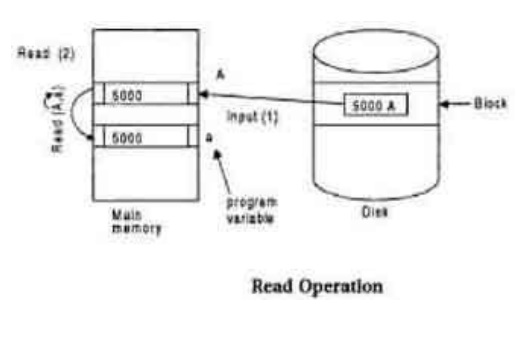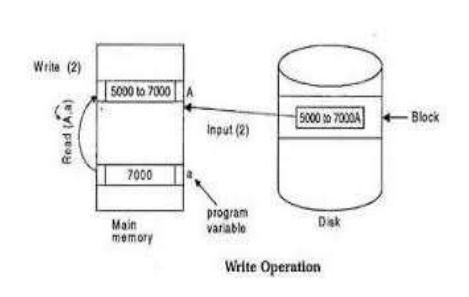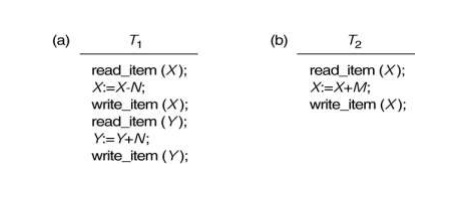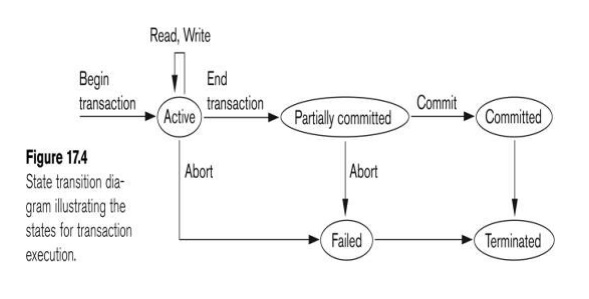Chapter: Database Management Systems : Transaction Processing And Concurrency Control
Transaction Processing
Transaction:
Action, or series of
actions, carried out by user or application, which accesses or changes contents
of database. It Transforms database from one consistent state to another,
although consistency may be violated during transaction
Logical unit of
database processing that includes one or more access operations (read
-retrieval, write - insert or update, delete).
Transaction is an
executing program forming a logical unit of database access operations that
involves one or more database operations (read -retrieval, write - insert or
update, delete).
A transaction may be
stand-alone set of operations specified in a high level language like SQL
submitted interactively, or may be embedded within a program.
A transaction must see a consistent database.
During
transaction execution the database may be inconsistent.
When
the transaction is committed, the database must be consistent.
Transaction boundaries:
Begin
and End transaction.
An application program
may contain several transactions separated by the Begin and End transaction
boundaries.
Two Basic operations are
read and write
1)
read_item(X): Reads a database item
named X into a program variable. To simplify our notation, we assume that the
program variable is also named X.
2)
write_item(X): Writes the value of
program variable X into the database item named X.
Why Do We Need Transactions?
It’s all
about fast query
response time and correctness
DBMS
is a multi-user systems
§
Many different requests
§
Some against same data items
v
Figure out how to interleave
requests to shorten response time while guaranteeing correct result
How does DBMS know which actions belong together?
Group
database operations that must be performed together into transactions
Either
execute all operations or none
READ AND WRITE OPERATIONS:
Basic unit of data
transfer from the disk to the computer main memory is one block. In general, a
data item (what is read or written) will be the field of some record in the
database, although it may be a larger unit such as a record or even a whole
block.
read_item(X) command
includes the following steps:
1.
Find the address of the disk block that
contains item X.
2.
Copy that disk block into a buffer in
main memory (if that disk block is not already in some main memory buffer).
3.
Copy item X from the buffer to the
program variable named X.

write_item(X)
command includes the following steps:
1.
Find the address of the disk block that
contains item X.
2.
Copy that disk block into a buffer in
main memory (if that disk block is not already in some main memory buffer).
3.
Copy item X from the program variable
named X into its correct location in the buffer.
4.
Store the updated block from the buffer
back to disk (either immediately or at some later point in time

Example Transactions:

Issues
to deal with:
o Failures of various
kinds, such as hardware failures and system crashes
o Concurrent execution
of multiple transactions
A transaction is
an atomic unit of work that is either completed in its entirety or not done at
all. For recovery purposes, the system needs to keep track of when the
transaction starts, terminates, and commits or aborts.
Transaction States
A transaction can be in one of several states:
Active -
Reading and Writing data items ,if something wrong happens during reading and
writing aborts to Failed.
Partially Committed -
All reading and writing operations are done aborts to Failed when rollback
occurs or committed when commit occurs.
Committed -
Transaction successfully completed and all write operations made permanent in
the Database
Failed -
Transaction halted and all operations rolled back
Terminated - terminates
either commits or failed

ACID Properties

To preserve the integrity of data, the database
system must ensure:
Atomicity. Either
all operations of the transaction are properly reflected in the database or
none are.
Consistency. Execution
of a transaction in isolation preserves the consistency of the database.
Isolation. Although
multiple transactions may execute concurrently, each transaction must be
unaware of other concurrently executing transactions. Intermediate
transaction results must be hidden from other concurrently executed
transactions. That is, for every pair of transactions Ti and Tj, it appears to
Ti that either Tj finished execution before Ti started, or Tj started execution
after Ti finished.
Durability. After
a transaction completes successfully, the changes it has made to the database
persist, even if there are system failures.
Example of Fund Transfer
Transaction to transfer $50 from account A to
account B:
1.read(
A)
2.A:= A- 50
3.write(
A)
4.read(B)
5.B:= B+ 50
6.write(
B)
Atomicity requirement :
1.
if the transaction fails after step 3
and inconsistent database state
2.
The system should ensure that
updates of a partially executed transaction are not reflected in the
database
Durability requirement :
once the user has been
notified that the transaction has completed (i.e., the transfer of the $50 has
taken place), the updates to the database by the transaction must persist even
if there are software or hardware failures.
Consistency requirement :
the sum of A and B is unchanged by the execution of the transaction
In
general, consistency requirements include
Explicitly
specified integrity constraints such as primary keys and foreign keys
Implicit
integrity constraints
A
transaction must see a consistent database.
During
transaction execution the database may be temporarily inconsistent.
When
the transaction completes successfully the database must be consistent
Erroneous transaction logic can lead to inconsistency
Isolation requirement :
if between steps 3 and
6, another transaction T2 is allowed to access the partially updated database,
it will see an inconsistent database (the sum A+B will be less than it
should be). Isolation can be ensured trivially by running transactions
serially, that is, one after the other. However, executing multiple
transactions concurrently has significant benefits.
Transaction states:
Active
state
Partially
committed state
Committed
state
Failed
state
Terminated
State
Recovery manager keeps track of the following operations:
o begin_transaction: This marks the
beginning of transaction execution.
o
read or
write: These specify read or write operations on the database items that
are executed as part of a transaction.
o
end_transaction:
This specifies that read and write transaction operations have ended and
marks the end limit of transaction execution.
p
At this point it may be necessary to
check whether the changes introduced by the transaction can be permanently
applied to the database or whether the transaction has to be aborted because it
violates concurrency control or for some other reason
q
commit_transaction:
This signals a successful end of the transaction so that any changes (updates)
executed by the transaction can be safely committed to the database and will
not be undone.
o
rollback (or
abort): This signals that the transaction has ended unsuccessfully, so that
any changes or effects that the transaction may have applied to the
database must be undone.
n
Recovery techniques use the
following operators:
o
undo:
Similar to rollback except that it applies to a single operation rather than to
a whole transaction.
o
redo:
This specifies that certain transaction operations must be
redone to ensure that all the operations of a
committed transaction have been applied successfully to the database.
Two Main Techniques
Deferred Update
No
physical updates to db until after a transaction commits.
During the commit, log records are made then changes
are made permanent on disk. What if a Transaction fails?
No
UNDO required
REDO
may be necessary if the changes have not yet been made permanent before the
failure
Immediate Update
Physical
updates to db may happen before a transaction commits.
All changes are written to the permanent log (on
disk) before changes are made to the DB. What if a Transaction fails?
After
changes are made but before commit –need to UNDO the changes
REDO
may be necessary if the changes have not yet been made permanent before the
failure
Recovery based on Deferred Update
Deferred
update
Changes are made in memory and after T commits, the
changes are made permanent on disk.
Changes
are recorded in
buffers and in
log file
At the commit point, the log is force-written to
disk and updates are made in database.
No need to ever UNDO operations because changes are
never made permanent
REDO is needed if the transaction fails after the
commit but before the changes are made on disk.
Hence the name is NO UNDO/REDO algorithm
2 lists are maintained:
Commit
list: committed transactions since last checkpoint
Active
list: active transactions
REDO all write operations from commit list in
order that they were written to the log
Active transactions are cancelled & must be
resubmitted
Recovery based on Immediate Update
Immediate update:
Updates to disk can happen at any time
But, updates must still
first be recorded in the system logs (on disk) before changes are made to database.
Need to provide facilities to UNDO operations which
have affected the db
2 flavors of this algorithm UNDO/NO_REDO
recovery algorithm
if the recovery technique ensures that all updates
are made to the database on disk before T commits, we do not need to REDO any
committed transactions
UNDO/REDO
recovery algorithm
Transaction is allowed
to commit before all its changes are written to the database o (Note that the
log files would be complete at the commit point)
Related Topics